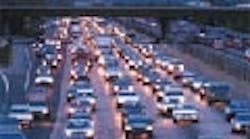As traffic jams in large cities escalate and spread to smaller areas, 35 states are now reporting that at least 40 percent of their urban Interstate highways are congested, up from 31 states the previous year, according to an annual study of the nation's highways.
Drivers in California, Minnesota, and North Carolina are stuck in the nation's worst traffic, over 70 percent of urban interstate highways in those states qualified as congested.
For the third consecutive year, Massachusetts had the safest highways (0.785 fatalities per 100 million vehicle miles traveled), while Montana's were the deadliest for the second straight year (2.364 fatalities per 100 million vehicle miles traveled).
The statistics come from the Reason Foundation's 17th annual report on the performance of state highway systems that measures the performance of all state-owned roads and highways from 1984 to 2006. The study calculates the effectiveness and performance of each state in 12 different categories, including traffic fatalities, congestion, pavement condition, bridge condition, highway maintenance costs, and administrative costs.
In California, 83 percent of its Interstate highways are congested, according to the study. Eighteen states now report that at least half of their urban interstate highways are congested.
Overall, 50.7 percent of the nation's urban interstate highways were congested in 2006, a slight one-percent improvement from 2005, when 51.8 percent were jammed. The statistical improvement is due, at least partly, to many states increasing the declared capacities of their highways.
North Dakota's state-owned highway system is the nation's most cost-effective, an honor the state has held since 2001. North Dakota finished first, or tied for first, in five of the report's 12 categories, including rural interstate condition. Montana jumped from 5th to 2nd in the overall performance and cost-effectiveness rankings. New Mexico continues to show marked improvement. The state ranked 27th in 2000, and was up to 3rd overall in 2006. Wyoming moves up from 7th in 2005 to 4th overall. Kansas rounds out the top five.
New Jersey, which has ranked last every year since 2000, continues to be the nation's least cost-effective and worst-performing road system. Despite having the nation's fourth smallest state-owned highway system, New Jersey finished dead last in five of the study's 12 categories. Several of the least populous states performed very poorly, and make up the rest of the bottom five: Alaska (49th), Rhode Island (48th), Hawaii (47th), and New Hampshire (46th).
Texas, home to the nation's largest state-controlled highway system, ranked 12th overall in performance and cost-effectiveness. South Carolina, owner of the country's fifth largest system, ranks sixth overall. Georgia, Ohio, Missouri, and Virginia are some of the other top-performing large states.
With urban congestion even hitting South Dakota, the list of states without any clogged interstates is down to just three: Montana, North Dakota, and Wyoming.
Deficient bridges were thrust into the spotlight in 2007 because of the tragic Minneapolis bridge collapse. Minnesota actually ranks fifth best in the nation, with 13 percent of its bridges deficient. Of the nearly 600,000 highway bridges in the country, 24.1 percent were reported deficient and/or functionally obsolete in 2006, a minor improvement from 2005 when 25.5 were deemed deficient. At the current rate of repair it will take 62 years for today's deficient bridges to be brought up to date.
In Rhode Island, 53 percent of state's bridges are deficient or obsolete. New Yorkers (38 percent deficient and obsolete) and Pennsylvanians (39 percent) won't feel much better about the condition of their bridges. Nevada has the lowest percentage of deficient bridges in the country, 3.9 percent.










